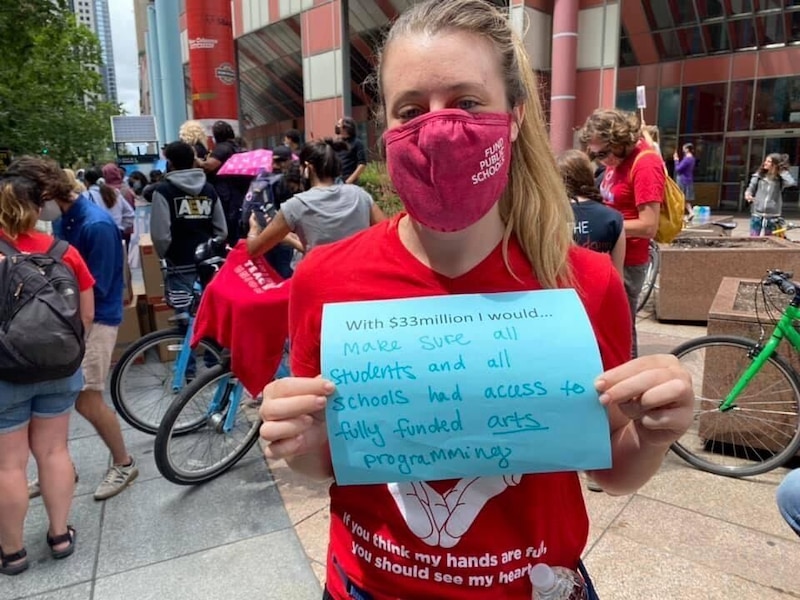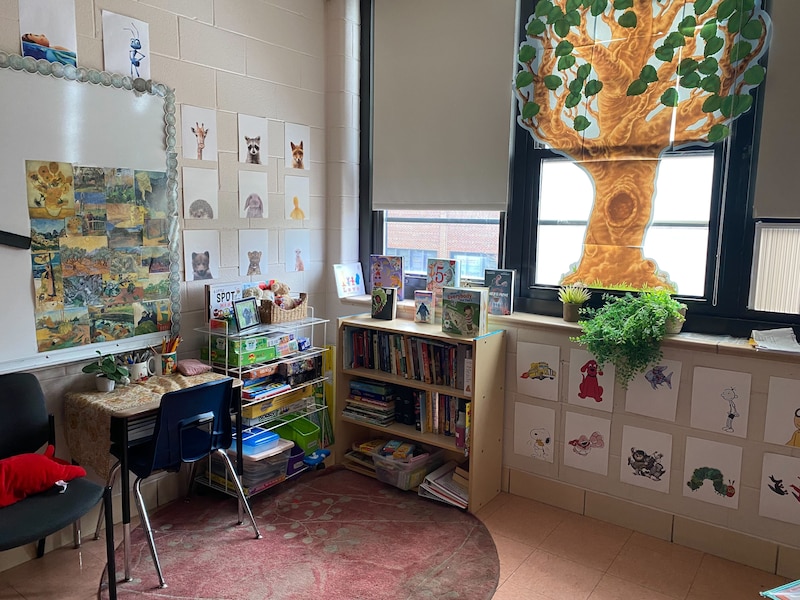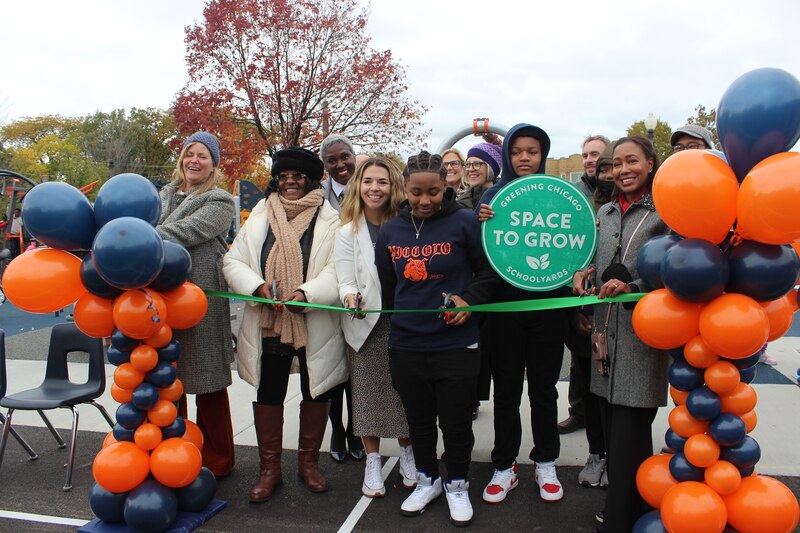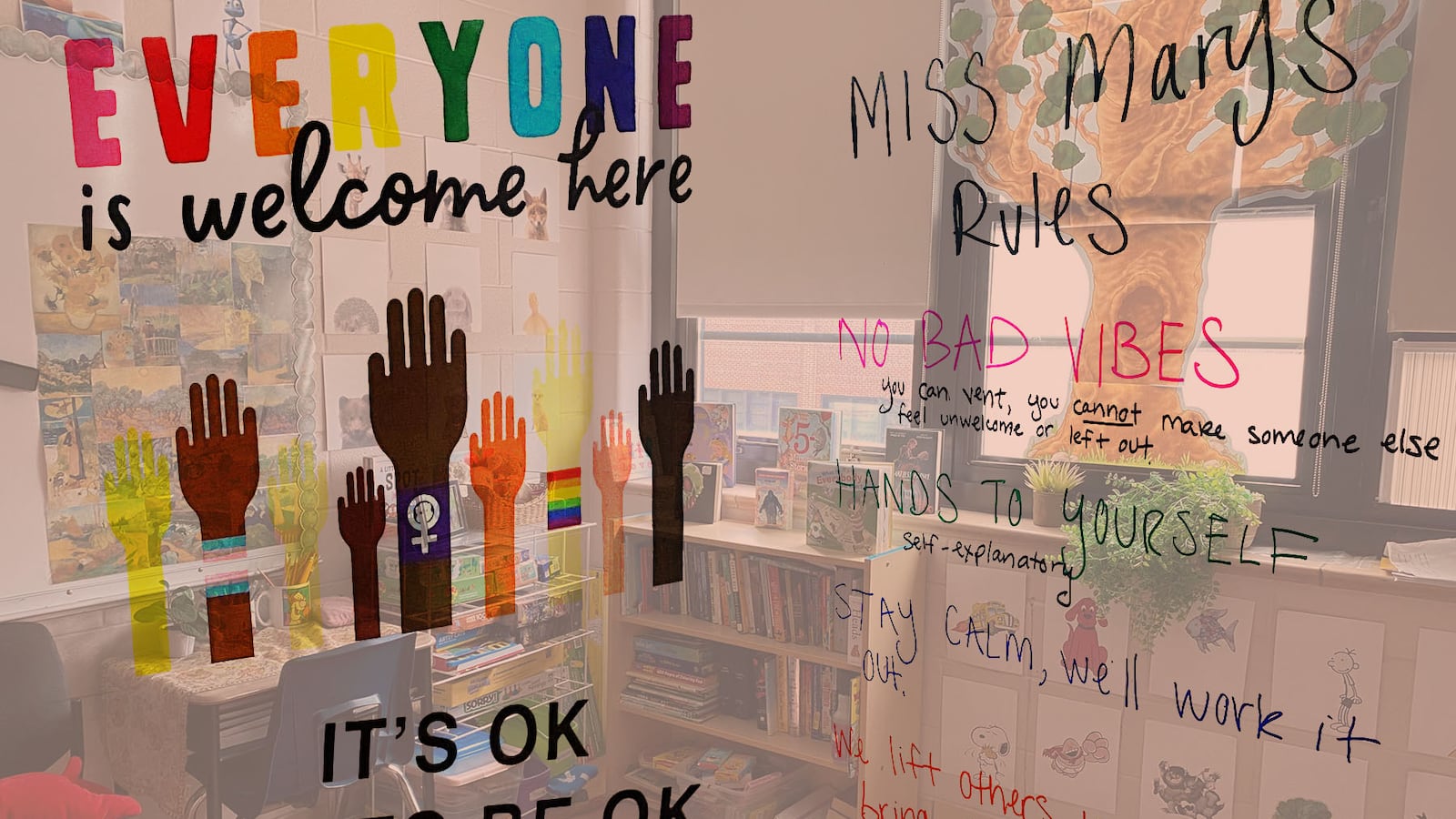Inside a staff bathroom at Piccolo Elementary School on Chicago’s West Side, Mary Difino wiped away tears and tried to catch her breath. It had been a long day in another stressful week.
A spate of fights and a string of cyberbullying incidents among students two months into the school year had taken a toll on Difino — the school’s only social worker.
In the last six years, she has juggled caseloads across two separate schools, participated in an 11-day teachers strike, and navigated a pandemic that upended schools for 18 months.
Still, Difino had harbored hopes that COVID-related disruptions had passed, and things might be getting back to normal. After all, this was supposed to be the year Chicago Public Schools — and its 322,000 students and 39,300 staff — recovered from the upheaval of the pandemic. This would be “one of the strongest years ever” in the district’s history, CEO Pedro Martinez said on the first day of school this fall.
At first, Difino felt that might be the case. Even her students described school as “more chill” with “less drama.”
But she soon realized her students’ trauma was deep-rooted.
Students were behind academically. Behavior problems were going up. Staff shortages at the school that serves Latino and Black students continued to stretch an already depleted workforce.
It felt, Difino said, “just as hard as last year.”
She was maneuvering between crises and helping the behavior team come up with school-wide plans to address some of the fighting and bullying. Plus, she still had to keep up with her regular caseload and small group counseling sessions.
Difino’s job as a school social worker is like “four jobs combined into one,” she says. She’s also responsible for supporting students with disabilities — and managing the paperwork that goes with their Individualized Education Programs or 504 plans — which includes doing diagnostic assessments and meeting with parents and other school staff.
In the bathroom, Difino took another deep breath, then headed back to her office. There she tidied up and fixed her desk. She grabbed her soccer bag from that morning’s Piccolo girls soccer team practice and a binder full of drills and activities. Her role as coach for second, third, and fourth grade students is a reprieve from her frenetic duties during school hours.
She thought about what was needed to calm the fights and help her students: a restorative justice coordinator, smaller class sizes, perhaps another social worker.
But as Difino left for home that night, that wish list seemed far away — and she just felt exhausted.
Chicago doubles number of school social workers
The week before students returned to Piccolo in August, Difino recruited her boyfriend to help set up her office.
They adjusted furniture, arranged plants, and decorated the walls with posters plastered with encouraging phrases such as “We rise by lifting others” and “Be the change you wish to see in the world.”
It would be Difino’s second year full-time at Piccolo, rather than bouncing between two separate schools. It is something she and other social workers in the district have long wanted: to be able to settle in and focus on one group of students in one community.

Difino often felt misunderstood as a young person, and gravitated to social work after years of working with at-risk students. She wanted to help kids who might not have the words to say what they’re feeling or what they need. Kids having a rough time at home. Kids needing a little extra support.
“I just thought it was purely wonderful there is a job that existed purely for those students,” she said.
When Difinio started her career in 2018, Chicago Public Schools had 337 social workers. Now, there are 618.
Until 2019-20, Difino juggled a caseload of about 100 students across two West Side elementary schools — Piccolo and Chalmers. It was, she says, a nearly impossible task.
That, in part, motivated Difinio to become more involved with the Chicago Teachers Union.
In her second year with the district, teachers went on strike for 11 days — and ended up winning provisions to increase the number of social workers and other key school staff. Under the contract between the district and the teachers union, every school must have a social worker by 2024.
Difino remembers the 2019 strike as a huge win, but it came at the cost of being villainized by some media and members of the public.
Federal COVID relief funds have since helped the district bolster its social and emotional staffing. Nationally, some school districts have struggled to hire these positions. In Chicago, 28 social worker positions remained unfilled district wide as of last month, according to the district staffing data.
The doubling of social workers in the district means there’s now one for roughly every 520 students — a huge improvement, but still short of what’s recommended by the National Association of Social Workers.
That organization says schools should staff one social worker for every 250 students. At schools where students are experiencing high levels of trauma, the recommended ratio falls to one social worker for every 50 students.
Even though Difino’s caseload has gone down, she still feels stretched — many days having to quickly pivot from one-on-one meetings with a student or small group sessions to deal with the fallout of a fight or another crisis. It often disrupts a consistent schedule for students in her caseload, she said.
Amid the pandemic that exacerbated pre-existing traumas and disparities, she questioned the district’s way of allocating funds for school social worker staffing positions, especially on the South and West sides — communities that were hard hit by COVID and experience higher levels of gun violence and disinvestment.
Social workers are assigned to schools based on the number of students with special education needs, population, and size. The district said it prioritized schools with the greatest needs.
Currently, every school has a social worker assigned to it. But they’re not all full-time. Only 392 schools have at least one full-time social worker, according to the district.
Federal funds also helped hire additional support, including counselors. According to Chicago Public Schools, 117 schools now have two counselors.
The district said in an emailed statement that it also aims to meet the social-emotional learning needs of students through additional crisis support, programs with wraparound services such as Choose to Change and Back to Our Future, and partnerships for supplemental mental health support with community groups and hospitals such as Ann & Robert H. Lurie Children’s Hospital.
But Difino wasn’t thinking about abstracts and funding philosophies when she set up her classroom.

She recalled students disoriented by unpredictable quarantines, countless fights, and behavioral problems. And she remembered accompanying a few students to the hospital and frequently staying long after dismissal to manage family crises.
“The lack of consistency was really hard” for students, their families and school staff, Difino said. “Last year, we had to learn all over how to be in school, with new routines, and precautions.”
The previous 18 months of remote and hybrid instruction presented other challenges for social workers trying to address very specific goals for students with Individualized Education Programs.
Instead of focusing on school work or academic and social goals, students often preferred to talk about the impacts of quarantines and remote learning. They just wanted someone to listen, she remembered.
On the first school day in late August, Difino arrived 40 minutes before the bell to put the final touches to her room. She greeted students in the halls and walked some kids to class while others stopped by her room to check whether they would be meeting this year.
She left campus that day feeling that this would be a more manageable year than the two years that preceded it.
That sense of optimism would not last long.
Student mental health needs multiply
The return to school has been shaping up as another challenging year across the nation, said Christy McCoy, the president of the School Social Work Association of America.
“The residual impact of the last couple of years with the pandemic, all the disruptions in schools, the increase of racialized violence — and community violence,” left lingering trauma that has sparked behavioral issues among students, McCoy said.
Some students are exhibiting more aggressive external behavior including bullying and fighting in middle schools and high schools, and internal behaviors with some children struggling to focus and pay attention in class, she added.
“We have youth that are really struggling with engaging and knowing how to do school again,” McCoy said. “When you think of all the gaps of learning that have happened in the last couple of years, youth are really struggling.”
In a statement, Chicago Public Schools said it had prioritized mental health, social-emotional learning, and support services amid the pandemic that “had a disproportionate impact on our communities of color.”
“We recognize that our students continue to struggle with the impact of the pandemic as well as ongoing trauma in their lives,” the district said in an email.
Jackie King-Papadopoulos, another social worker with the district, put it more simply: At this moment, every school has high needs.
“I think that every student that is in Chicago Public Schools, every teacher, every adult that is in Chicago Public Schools is adjusting to life in this pseudo-post-pandemic world,” said King-Papadopoulos, who works at Morton School of Excellence in East Garfield Park.
Last year, King-Papadopoulos started the year at an elementary school in Austin before she was transferred to another school in Uptown. Amid higher expectations, teachers were trying to help students catch up academically while also dealing with challenging behavioral concerns, she recalled.
“Whenever you have that much of a struggle with academics, the social and emotional part is going to really be impacted as well,” King-Papadopoulos noted.
The pandemic has had a varied impact on students. The youngest children are learning to be around other kids, while middle school children are relearning how to be in a classroom, she said. Others are just not coming to school at all, adding to the social worker’s concerns about chronic absenteeism.
At Morton, King-Papadopoulos noted there is still some carryover of fighting among middle school students, but she has heard from teachers and staff that the students who struggled the most with disruptive behavior last year are doing much better this year.
“I think that everybody has made some positive strides in terms of how they’re coping with things,” King-Papadopoulos said. “I do think that everybody’s kind of breathing a sigh of relief that’s so far this year, feels about as normal as they think that it possibly can.”
King-Papadopoulos has been able to meet her caseload, handle new referrals, hold small group interventions, visit classrooms, support teachers, and is part of the behavioral health team.
But it is sometimes a juggling act, she acknowledged. “I also feel like everybody feels like the situation is very tenuous.”
Social workers confront fights, bullying, paperwork
At Piccolo Elementary, the honeymoon phase of the new school year quickly ended.
Difino scrambled to respond to big fights and bullying. She zagged between mediating conflict resolution and connecting parents with resources. She accompanied a student experiencing a mental health crisis to the emergency room.
And the physical fights didn’t let up — some even involved family members during school dismissal. In mid-September, there were four brawls in one day, involving about 16 students, she recalled.
It took an “all-hands-on-deck” approach — by Difino, the principal, school counselor, and other Piccolo staff — to untangle which students were involved, come up with potential restorative approaches and consequences, work out a safety plan, and fill out paperwork to document the fights.
“I don’t think any of us will really understand the effect that quarantine and COVID had on us,” she said later, “but I think that behaviors become habits really quick.”
On days like that, Difino said, school social workers are forced to make tough decisions of whether to scrap some responsibilities to handle a crisis or not respond to a crisis within 24 hours as required.

In Difino’s five years at Piccolo, she has seen the school add more programming for students before, during, and after school. She credited the principal with bringing in six community partners to do art therapy, sports programs, and providing supplemental counseling, as well as implementing initiatives that center the voice of students.
On paper, Difino’s school is considered adequately staffed by district standards. According to district staffing data, Piccolo has a dean of students, a school counselor, at-risk student coordinator, and a few security staff. It also partners with Becoming a Man, or BAM, to offer counseling and social emotional services to Latino and Black boys.
Still, Difino said it still doesn’t feel like enough to address the persistent behavioral concerns.
“There’s just not enough manpower in the building to do all of that when there is such a high frequency of fights and police-involved incidents — on top of your regular responsibilities,” she said. She advocates for smaller class sizes, more staff to help mediate conflicts, and more affordable housing for students and their families.
“It’s like every school is seen as a spreadsheet,” she said, “not as humans with unique needs, or communities with unique needs.”
On one early December day, as the school year trundled to winter break, Difino pivoted from helping a student in crisis for a few hours to meeting with a mother and her child for an annual IEP assessment. For about an hour, they discussed the previous year’s goals and made new objectives for the rest of the year.
Difino spent the next few hours in her office, filling out forms and writing up paperwork.
Piccolo students are grappling with so much outside of the school walls — too many guns, not enough food, no stable places to call home, said Difino. Those pressures often translate into classroom disruptions or academic struggles.
“When kids have big behaviors, it’s really easy to not see them as a kid anymore,” Difino said. “Usually when they have difficult behaviors, they don’t have the words to say what they’re feeling or going through.”
After the holidays, she hopes to get back to a consistent schedule for her small groups and build on the progress she is seeing in her students.
She envisions tailoring activities around their specific needs and interests. Maybe talking about basketball. Or incorporating play-based learning with Legos.
She still believes in what she does and, she says, no matter the obstacles — the lack of support from the district, the cascading responsibilities — she will find a way to do her job.
Purely for the students.
Mauricio Peña is a reporter for Chalkbeat Chicago covering K-12 schools. Contact Mauricio at mpena@chalkbeat.org.

